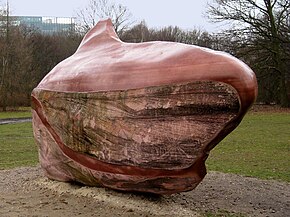Global Stone
Global Stone is a work of art originally intended as a peace project by Wolfgang Kraker von Schwarzenfeld (* 1933).
Project
The aim of the project is to look for two particularly characteristic stones of about 30 tons on each continent , one of which will be given a place in the Great Tiergarten in Berlin near the Brandenburg Gate and its counterpart will remain in a special place in the country of origin. The polished reflective surfaces of the stones should be aligned in such a way that every year at the summer solstice on June 21, the rays of the sun create a connection between the stones in the continents and their sister stones in Berlin as well as between the five Berlin stones. This is to symbolize the connectedness of people all over the world.
There are currently stones from Russia , Venezuela , Australia and South Africa in the Berlin Zoo. Kraker von Schwarzenfeld gave the stone pairs names to symbolize the “five steps to peace” that he believes are crucial. The names are:
- Europe - awakening
- Africa - hope
- Asia - forgiveness
- America - love
- Australia - peace
Kraker von Schwarzenfeld sailed around the world with the three-master Pegasus he built himself 37 years ago . The sailing ship and the voyage became the basis for the idea of this project. The entire project is privately financed. In addition to Kraker von Schwarzenfeld, a number of sponsors bear the enormous costs of the project.
Discussion about the “Kueka” stone
The stone of love , installed on February 24, 1999, comes from the Gran Sabana nature reserve in Venezuela from the area of the indigenous people of the Pemón , from where it was removed at the end of 1998. The stone has been causing discussions since shortly after arrival.
The local Pemón of the municipality of Santa Cruz de Mapaurí describe it as one of two "sacred stones" that was removed without their consent. Since the time of his departure, they have been fighting for his return. Since 2011, the case has even preoccupied the Venezuelan government, which initiated legal action on April 25, 2012 because of the stone. The Latin American regional office of UNESCO supported them in this.
The artist defended himself against the allegations and cited an opinion from the ethnologist Bruno Illius, who was carrying out a research project at the Latin America Institute of the Free University of Berlin . He considers the myths about the stone to be politically motivated inventions by individuals and refers to interviews with various Pemón Indians and numerous discrepancies and incorrect translations in the films published on the case.
Recent research - u. a. on behalf of the Goethe-Institut - showed that local attribution of myths in the immediate surrounding landscape of Pemón settlements is common practice, and that the inhabitants of the municipality of Santa Cruz de Mapaurí have called this stone "Kueka" since the village was founded in the 1970s . In addition, the colonial gesture of stone removal moved into the focus of the debate, with the indication that the removal took place at a time when the Venezuelan pemón had hardly any fundamental political rights. The Federal Foreign Office recently negotiated with the Venezuelan government to return the controversial work of art to the Pemón. Finally, the stone was brought to Venezuela in April 2020.
literature
- Bruno Illius: The stone of love. In: Hanna Heinrich and Harald Grauer (eds.): Paths in the Garden of Ethnology , Sankt Augustin: Academia Verlag 2013, pp. 131–157, ISBN 978-3-89665-632-2 .
Web links
- The project
- Documentation on YouTube: Venezuelan Pemón Indians fight for the return of "Abuela Kueka"
Individual evidence
- ↑ Holy Stone returns to Venezuela. Retrieved August 19, 2020 .
- ^ Project description on the website of Global Stone - A Worldwide Peace Project
- ↑ Circumnavigator starts action - a stone has a connection between nations. In: Berliner Zeitung , February 25, 1999.
- ↑ Melissa Eddy: A Rock Fated to Anger Nations . In: The New York Times . July 11, 2012, ISSN 0362-4331 ( nytimes.com [accessed January 29, 2020]).
- ↑ The Monolith of Doom . In: Frankfurter Allgemeine Zeitung , August 9, 2000, No. 183 / page BS 5 (Berlin pages)
- ↑ Holy stone in the zoo angered Indians in Venezuela . In: Berliner Kurier , August 9, 2000, No. 126/2000 - A11916
- ↑ Indians reclaim boulders from Germany. In: Spiegel Online , June 22, 2012
- ↑ The stone of love. In: Der Spiegel 38/2011, September 19, 2011
- ^ Ministers of Culture and Heads of Delegation: 2nd Meeting of Ministers of Culture of The Community of Latin American and Caribbean States. In: unesco.org. Regional Office for Culture in Latin America and the Caribbean, August 21, 2014, accessed May 12, 2018 .
- ↑ Illius, Prof. Dr. Bruno - cibera ResearcherWiki. Retrieved January 29, 2020 .
- ↑ Comments on the debate about the “Kueka” Venezuelan stone in Berlin's Tiergarten (part of the “Global Stone” project) . (PDF; 207 kB)
- ↑ Completed research projects. December 5, 2016, accessed January 29, 2020 .
- ↑ hneuber: Dispute settled: Kueka-Stein returns from Berlin to Venezuela. January 21, 2020, accessed January 29, 2020 .
- ↑ Indigenous stone from Berlin back in Venezuela. k.at, accessed on April 17, 2020 .
Coordinates: 52 ° 30 ′ 46 ″ N , 13 ° 22 ′ 26 ″ E
